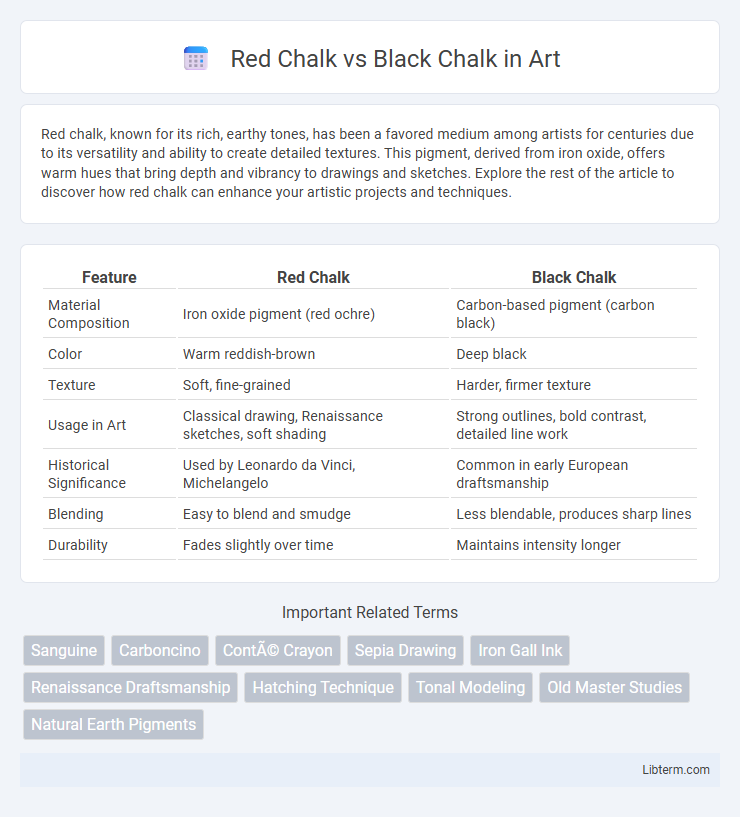Red chalk, known for its rich, earthy tones, has been a favored medium among artists for centuries due to its versatility and ability to create detailed textures. This pigment, derived from iron oxide, offers warm hues that bring depth and vibrancy to drawings and sketches. Explore the rest of the article to discover how red chalk can enhance your artistic projects and techniques.
Table of Comparison
| Feature | Red Chalk | Black Chalk |
|---|---|---|
| Material Composition | Iron oxide pigment (red ochre) | Carbon-based pigment (carbon black) |
| Color | Warm reddish-brown | Deep black |
| Texture | Soft, fine-grained | Harder, firmer texture |
| Usage in Art | Classical drawing, Renaissance sketches, soft shading | Strong outlines, bold contrast, detailed line work |
| Historical Significance | Used by Leonardo da Vinci, Michelangelo | Common in early European draftsmanship |
| Blending | Easy to blend and smudge | Less blendable, produces sharp lines |
| Durability | Fades slightly over time | Maintains intensity longer |
Introduction to Red Chalk and Black Chalk
Red chalk, derived from iron oxide pigments, offers warm, earthy tones ideal for detailed drawings and Renaissance artworks, whereas black chalk, made from natural carbon-based minerals, provides rich, dark lines favored for sketches and shading. Red chalk, also known as sanguine, is prized for its smooth texture and subtle color variations, making it a classic medium in portrait studies and figure drawing. Black chalk delivers strong contrast and sharp definition, commonly used in preliminary sketches and outline work due to its intensity and ease of blending.
Historical Uses of Red and Black Chalk
Red chalk, historically favored by Renaissance artists such as Leonardo da Vinci for its warm tones, was commonly used in sketches and preparatory drawings to enhance anatomical and figure studies. Black chalk found widespread use during the Baroque period, valued for its rich, deep lines that emphasized dramatic contrasts and textures in portraiture and landscapes. Both materials played crucial roles in the evolution of draftsmanship, with red chalk often chosen for subtle shading and black chalk for precise, bold outlines.
Composition and Material Differences
Red chalk, primarily composed of iron oxide mixed with clay and sand, provides a warm, earthy tone ideal for fine detail and shading in drawings. Black chalk, made from natural carbon-rich rock or treated black chalkstone, offers deeper, more intense lines and a smoother application on various papers. The distinct mineral compositions directly affect texture, color intensity, and blending properties, influencing artists' material choices based on desired visual outcomes.
Visual Characteristics: Hue and Texture
Red chalk exhibits a warm, earthy hue with a subtle reddish-brown tone that adds softness and warmth to artwork, while black chalk presents a deep, intense black or dark gray color that offers strong contrast and bold definition. The texture of red chalk is typically smooth and powdery, allowing for gentle shading and blending effects, whereas black chalk has a firmer texture ideal for crisp lines and detailed contouring. Artists often choose red chalk for its delicate tonal range and black chalk for its precision and striking visual impact.
Techniques for Drawing with Red Chalk
Red chalk, composed primarily of iron oxide, offers artists a warm, earthy tone ideal for creating subtle tonal variations and soft shading in drawings. Techniques for drawing with red chalk include cross-hatching, blending with fingers or stumps to achieve smooth gradients, and leveraging the natural grain of the paper to enhance texture and depth. Mastery of pressure control allows artists to produce both delicate lines and rich, dense areas, making red chalk especially favored for portraiture and studies of the human form.
Techniques for Drawing with Black Chalk
Drawing with black chalk employs techniques such as hatching, cross-hatching, and blending to create depth and expressive lines. Artists often use the medium on textured paper to enhance tonal variation and allow subtle gradations of shading. The soft, powdery nature of black chalk enables both precise details and broad strokes for dynamic contrast in artwork.
Famous Artists and Masterpieces in Chalk
Red chalk, favored by Leonardo da Vinci and Raphael, is renowned for its warmth and subtlety, evident in da Vinci's "Study of a Woman's Head" and Raphael's intricate portraits. Black chalk, preferred by Michelangelo and Rembrandt, offers strong contrasts and precision, showcased in Michelangelo's "Studies for the Libyan Sibyl" and Rembrandt's expressive self-portraits. Both mediums have been instrumental in producing masterpieces that highlight texture and depth in classical drawing techniques.
Preservation and Longevity
Red chalk, composed primarily of iron oxide, exhibits superior preservation qualities due to its chemical stability and resistance to fading over time, making it ideal for long-lasting artwork. Black chalk, often made from carbon-based materials like charcoal or graphite, tends to be more susceptible to smudging, surface degradation, and fading when exposed to light and environmental factors. Museums and conservators frequently prefer red chalk drawings for their durability and enhanced longevity in archival conditions.
Choosing Between Red Chalk and Black Chalk
When choosing between red chalk and black chalk, consider the desired contrast and texture for your artwork. Red chalk offers warm, earthy tones ideal for detailed portraits and soft shading, while black chalk provides deeper, sharper lines perfect for strong outlines and dramatic effects. The choice depends on the artistic intent and the surface compatibility, as red chalk performs best on lighter papers and black chalk excels on both light and toned backgrounds.
Modern Applications in Art and Design
Red chalk offers rich, warm tones ideal for creating expressive portraits and detailed sketches in modern art, frequently used for emphasizing texture and depth. Black chalk, prized for its deep, intense lines, excels in dynamic figure drawing and architectural designs, providing strong contrast and precision. Both mediums remain essential in contemporary design, enabling artists to explore varied tonal ranges and enhance visual storytelling across diverse creative projects.
Red Chalk Infographic

 libterm.com
libterm.com